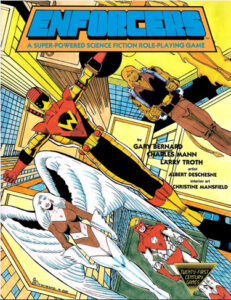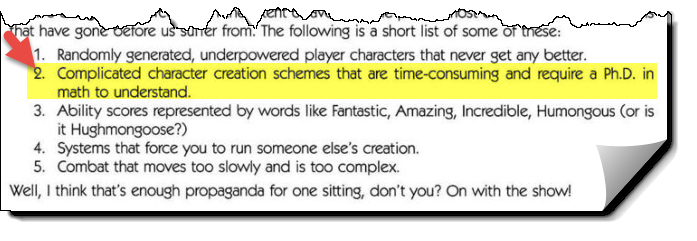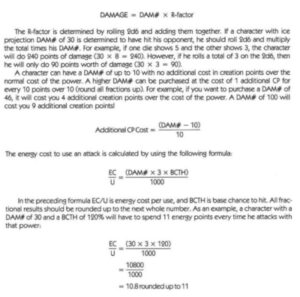Enforcers
Enforcers
Another Forgotten Superhero RPG
But The Only One I Know Of To Include A Lotus 1-2-3 Program VIP Professional Spreadsheet For Character Sheets
Not On A Disk, Mind You. You Have To Type It In.
Return with us now to the glorious late 80s, when the dawn of desktop publishing and laser printers meant anyone could design an RPG, and did! When it came to superheroes, the leaders were TSR’s Marvel Superheroes game, now often referred to as the FASERIP system; Champions, which published the 3rd edition in 84 and 4th edition — IMO, the best single-book universal rules ever published — in 1989, and Mayfair’s DC Heroes game, introducing the MEGS (Mayfair Exponential Gaming System) to the world.
With two big-name licensed systems and a clear leader in non-licensed systems out there, what could Enforcers bring to the table?
Not bloody much, which is why you’ve never heard of it. But, oh, they were confident in their vision and contemptuous of the competition.
Also, I have to wonder if they read their own game, at least based on reading the opening paragraphs, then flipping quickly through the rest of it.
What am I talking about, you ask? (Yeah, as if anyone is reading this.)
We’ll start with the introduction, where they discuss everything wrong with competing systems.
Highlight added, of course. Now, the most complex game I know of in the superhero genre at the time was Champions, and it required about 4th grade math – multiplying by fractions. So, with that as the standard, we assume “multiplication” is what “requires a Ph.D. in math to understand”.
Meanwhile, flipping through the book, you see stuff like this (which is only 4 pages after their “Math is Hard!” declaration):
So, uhm… yeah.
As for “using words for attributes”, well, there’s hundreds of fan sites and high-quality fan made supplements for Marvel Super Heroes, 30+ years later, but good luck finding an “Enforcers” site/forum/Discord/OnlyFans out there.
But is this opprobrium earned? Is there an undiscovered gem hidden within? Quite a few games have overly self-congratulatory introductions, mixed with bitter bile cast at those blind fools at other gaming companies who do not recognize the author’s genius, but which, despite this, are at least competent (often indicating someone other than the public face of the publisher did the work). If I were stuck on a desert island with only Enforcers, would I run it for the local crustaceans before dinner? Let’s find out.
Narrator: “As it turns out, he would not run it for crustaceans on a desert island. He might boil them alive and then devour their innards, but running this game for them would constitute unconscionable cruelty.”
Enforcers Character Creation
As noted in the headers, the authors helpfully included a Lotus 1-2-3 spreadsheet you can… eh? Oh, Lotus is what everyone used before Excel, replacing Visicalc. Hm? Visicalc was the first killer app for the Apple II, and… Yes? No, not like Tik-Tok! That’s not what “app” meant back then you little… get offa my cyberlawn! Stupid kids. Where was I?
Oh yeah. I’m not gonna dig up a Lotus emulator and type in 5 pages of… hang on.
This isn’t Lotus. I just assumed. It’s something called “VIP Professional Spreadsheet” run on..Atari 1040??? They not only expected you to type in a mountain of code, but to do so on a no-name spreadsheet on a virtually ignored — even at the time — platform? Look, people, I was selling computers in 1987. PC compatible was king. Macintosh was for artsy counterculture types (who were also wealthy, as they were expensive systems!). Amiga had a solid niche in sound and video, as well as games. And Atari? Barely a blip.
Anyway. Let’s make a character.
I’m going to regret this. I just know it.
First, we start with character concept. That’s fine, but other than “Superhero, I guess?” there’s not much guidance. We should, for example, pick our sex, age, and race, and it notes these things can “play important roles”, but are there mechanics involved? A teenager, it says, may be stuck taking an algebra test when a villain is attacking the city – so do we get points for being a teenager?
I guess I’ll use the character I am currently playing in an online FASERIP game, the Human Tank, transporting him from World War II to… when is this game set? Most superhero games use a generic “present day”, but this is “a super-powered science fiction” RPG. And, yeah, I remember, the back cover says it’s 2046 (wanna bet if they have computers in the equipment section, they’re notably inferior to mid-90s models?). Hmm. It seems superheroes exist due to pollution and alien weapons. So, fine, I’ll just use the same power concept (basically, guy who can transform into an armored, super-strong form, ala Colossus, but not a mutant, and he’s a lot more angular in appearance) and fit that into the world. In the FASERIP system, he can lift 10 tons without straining, so that’s a good test of the system. If a new character can’t manage 10 tons, pretty low-end for super-strong heroes, it fails a key metric.
So, he’s a white guy from Philadelphia, mid-20s, probably 140 in human form, 500 in tank form, his powers are strength and armor, and he got them by being experimented on by a super-villain.
Acts Of Creation (Points)
The GM will decided how many creation points you get. I’ll pick the mid-range, 25.
And now, in this system which promises no “randomly generated, underpowered player characters”, I roll 4d6 (take three highest) for my stats. So, holupaminnit… I am told to define my concept and powers first, then roll to see if my attributes match the concept? I can spend CP to raise attributes, sure, but depending on my rolls, I may or may not have enough CP to reach my goals. (At least they’re cheap, for the most part.)
STR: 15
CON: 15
ADX: 16 (Agility/Dexterity)
INT: 11
CM: 12 (Comeliness)
MR: 10 (Media Rating) — no, wait, it starts at 0 and cannot be increased by spending CP.
WT: 140, as noted above. Except you can also roll it. This isn’t mentioned in the character concept page, of course.
PS: “The Comeliness score is not referred to anywhere else in these rules. ” Yes. You roll for it, you can raise it, but it’s entirely up to the GM what it means. The game suggests it “has such vital uses as picking up desirable members of the opposite sex in bars”.
Anyway, let’s see what it takes to lift 10 tons (and whadda ya get?).
OK, so, for this game that doesn’t require a Ph.D. in math, here’s what it takes to figure out how much can lift:
Oh, that “W*”? That means “Weight Factor”. But is it my human weight, or my transformed weight? Hey, how do I make a character with alternate forms, anyway? (Flips through powers.) Not really any way to do that. But the back of the book promises that this is the “most flexible” super-power role playing game, and it says you can “create your open super-powers”!
More flipping.
There’s a “mutation” power, which is “You bribe the GM to let you make up a power.” (Slightly paraphrased)
That’s it.
That’s their idea of rules to “create your own super-powers”. Beg the GM to let you. Pro Tip: Every game allows you to bribe the GM. It’s not a feature you call out as a selling point.
Also, my armor has weight, but the rules are really unclear if it applies to my carrying capacity formula or not. Also also, armor in this game is a giant pool of extra hit points. It doesn’t reduce damage per attack, or chance to hit (except for artificial armor, whose rules I’m not going to look up just now). So do I need to figure out my adjusted weight to then figure out how much strength I need? It says armor weighs 2 pounds per point — is that per character point, or per armor point? One CP = 75 points of armor. I’m guessing it means ‘per character point’, as otherwise, a single CP of armor would mean you’re carrying an extra 150 lbs.
So, fine, we’ll use the 140 lbs for now. The weight factor is Weight/50, round up, so, 3. Str/10=1.5, cubed is 3.375. That times 3=10.125, times 25 equals 253 lbs. So what Str do I need to lift 10 tons? Who the hell knows? I’ll have to fire up Excel, enter this formula, and adjust Strengh until the number comes out right. I don’t wanna. But I’m gonna, then I’m gonna quit.
65. I need a strength of 65, and, at 1 CP per 5 attribute points, that takes 10 of my 25. Actually affordable, probably, as armor is pretty cheap, too.
My “damage number”, BTW, is 15, which I get by looking up my CC (20,596 lbs) on a long chart in the back. The chart is determined, they helpfully inform us, as: (DAM#X x 100) + (CC DAM#X -1) + (DAM#X3 x LOG{DAM#X} x 0.7).
OK, I’ve found a game that is worse at doing its job and meeting its declared design goals than Cyborg Commando. But unlike that, it’s not an amusing train wreck. It’s just a mess. Road Rebels was a mess, too, but it was a sincere mess and I felt the writer was doing their best. Synnibarr is just so bonkers insane it was worth pushing though. But for this, I have no patience. I can’t find a trace of a redeeming feature. I’m going to do something I haven’t done in 13 or so years of writing these walkthroughs: Say “fuck it” and not even attempt to finish.





FWWI, I’d have just written “Atari ST” — which model isn’t that relevant and if you write “Atari 1040”, I (who owned a 1040ST in 1989) will start out assuming it’s one of the early Atari 8 bit machines that were basically general purpose versions of the game machines (or just game machines).
The ST never had the traction of the Amiga, PC, or Mac, but it wasn’t that dire, overall. The performance was similar to an Amiga and it was popular enough to have many/most Amiga games also get made for it as well. I still wouldn’t have released a game with that as the sole character spreadsheet, but then, electronic supplements were rare in 1985.
It’s more the “type it in” part I find amusing. I know from painful experience in the days of Creative Computing that when a program you need to type in exceeds a very low minimum size, you will enter in bugs, and tracking them can be very difficult as you flip from the paper listing to the code listing and back.
A few years later, you’d have a BBS number to DL the sheet from, a few years after that, an FTP site.
What’s weird to me is that the ST didn’t have a standard computing language! It’s part of the 16 bit generation, not the 8 bit which usually had basic and magazines of type-in-able programs available designed to leverage this (before, but continuing througgh the period where there were plenty of programs you could buy on disc as well, to the point where Compute etc started shipping with a disc themselves so you didn’t actually have to type the code in).
The ST, by contrast, is a full GUI OS. Of course, you could still have people type in a binary program. And, I suppose, “St Basic” ws technically bundled with the machines, but in all the years I used it, I don’t think I ever started that up; I went from a pile of pirated games that were my main incentive to buy that system rather than an Amiga, to downloading and installing gcc and much of the rest of the Gnu uitlities (in which case I’d expect to compile programs in C, not Basic — I knoew I had it spend hours recompiling emacs for the ST at more than one point).
So yeah, having a program you type in for a 16 bit computer, while common for the 8 bit ones (I’m not convinced I ever did type an 8 bit program in either, but then my typing didn’t take a massive speed upgrade (and accuracy, despite still making plenty of typos) up until I had a modem and then Internet connection and was chatting with people online every day) was a super rare thing in the late ’80s, when I the ST was even available.